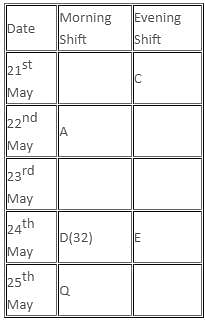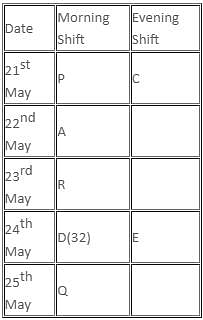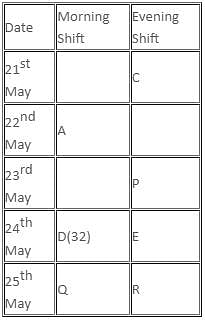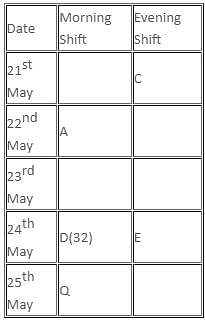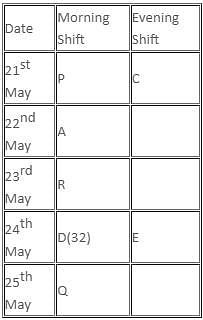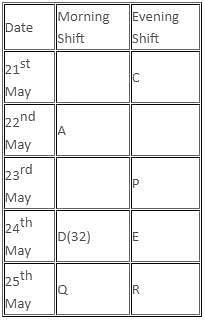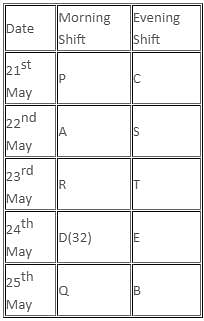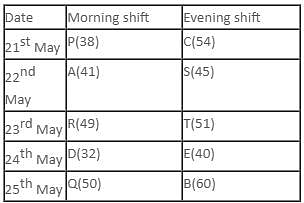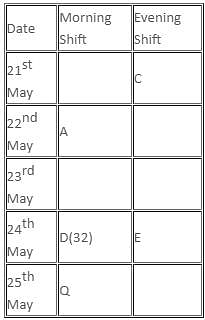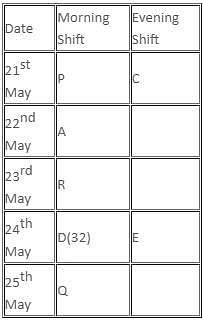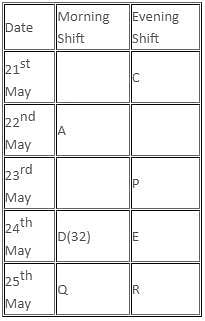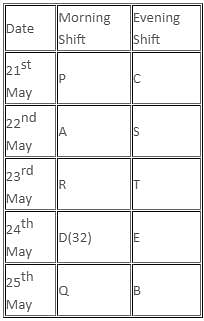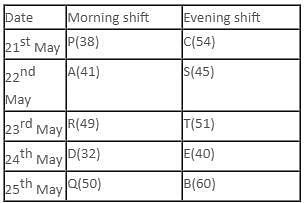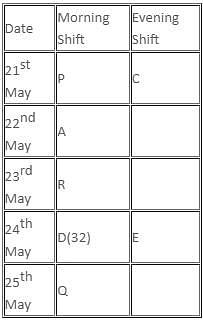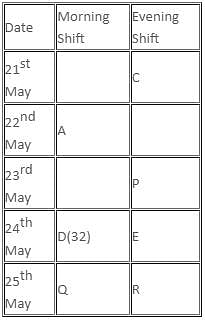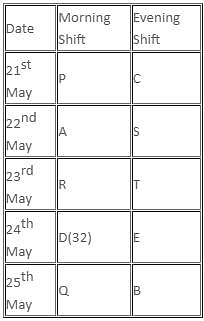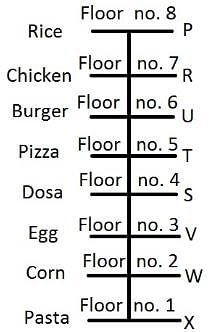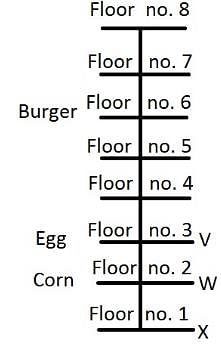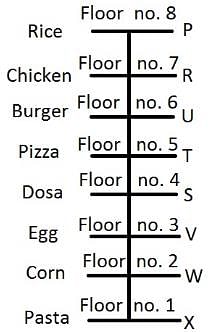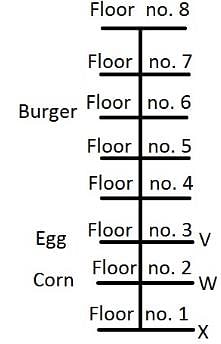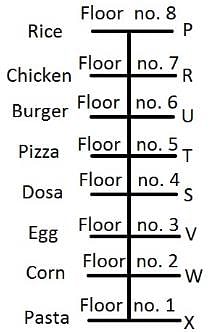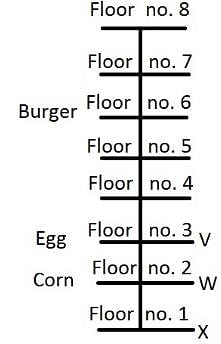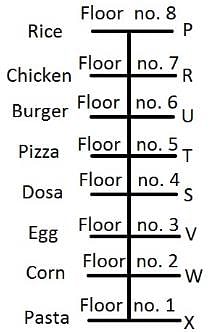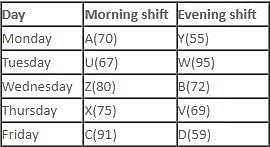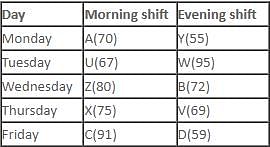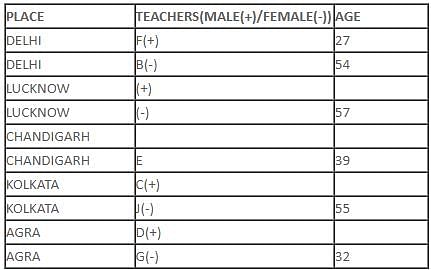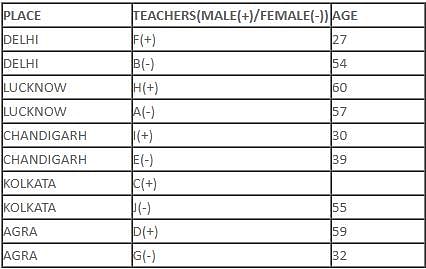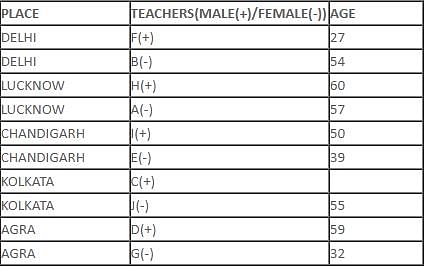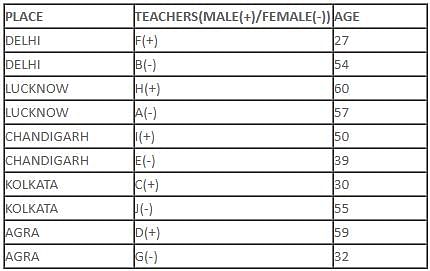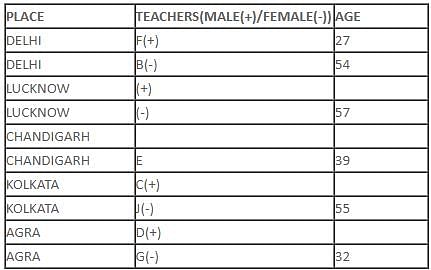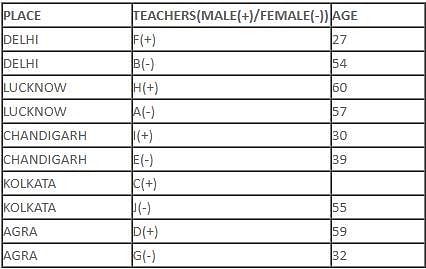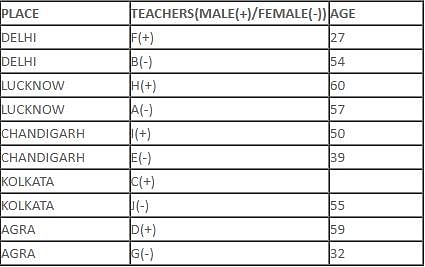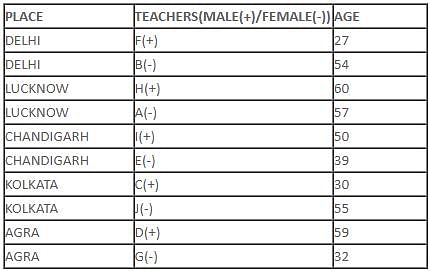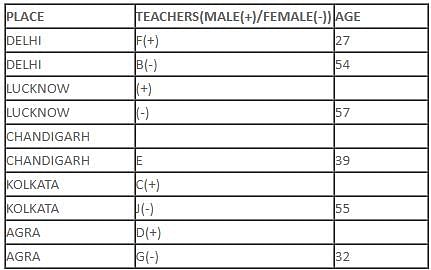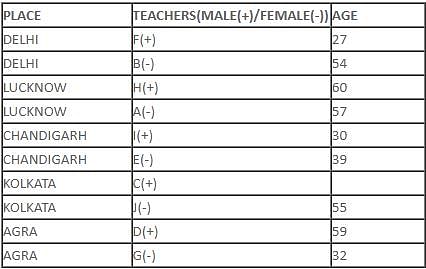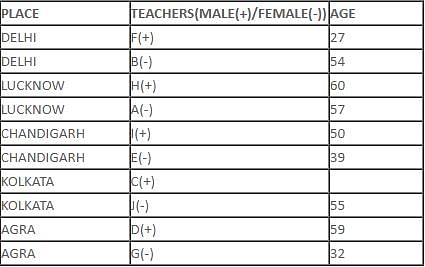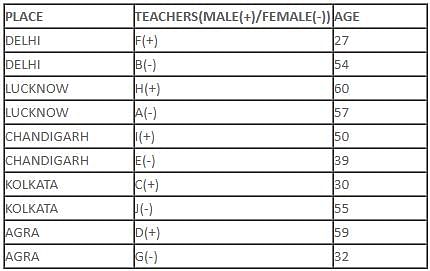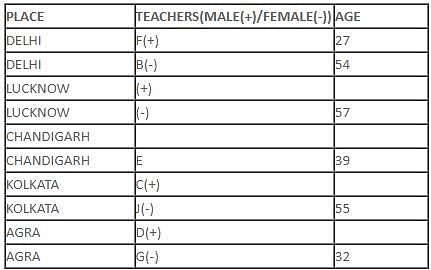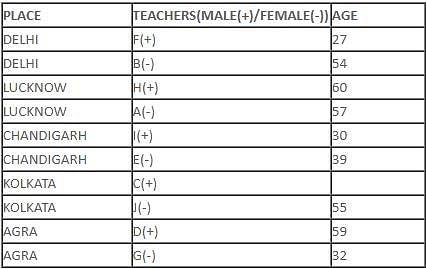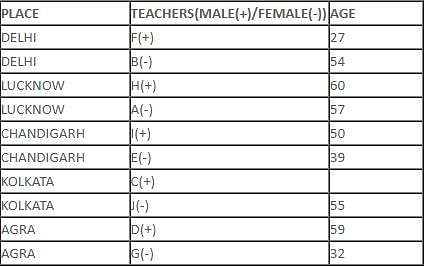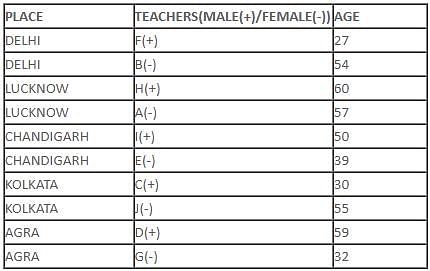Test Level 2: Games and Tournaments - CAT MCQ
20 Questions MCQ Test Level-wise Tests for CAT - Test Level 2: Games and Tournaments
Directions: Read the given passage and answer the question that follows.
A museum allowed groups of students from ten different schools A, B, C, D, E, P, Q, R, S and T to visit it in 10 different shifts over five days, from 21st May, 2018 to 25th May, 2018. There were two shifts (morning and evening) on each day and in a particular shift, only one school could visit. Each school came with a different number of students. The schools were instructed to bring at least 30 students, but not more than 60 students. None other than these ten schools visited the museum over these five days.
Over these five days, 210 students visited in the morning shift and 250 students visited in the evening shift. School D visited on 24th May with 32 students. The total number of students who visited in the two shifts on 23rd May was 100. Three schools visited the museum between schools D and A. School R visited the museum two days after school P, but in the same shift. School E visited the museum three days after school C, but in the same shift. School C visited the museum with 13 more students than school A, but on a different day. The sum of the numbers of students from schools E and B was the same as the sum of the numbers of students from schools R and T. School Q visited immediately after school E, but with 10 more students. The school that visited last came with 60 students. One school visited the museum between school S and school T. School T visited the museum after school S with 10 more students than school A. The number of students who came from school R was a square number. The numbers of students who visited from schools C and S were multiples of 9. The number of students who visited from school C was more than that from school S.
How many students from school P visited the museum?
A museum allowed groups of students from ten different schools A, B, C, D, E, P, Q, R, S and T to visit it in 10 different shifts over five days, from 21st May, 2018 to 25th May, 2018. There were two shifts (morning and evening) on each day and in a particular shift, only one school could visit. Each school came with a different number of students. The schools were instructed to bring at least 30 students, but not more than 60 students. None other than these ten schools visited the museum over these five days.
Over these five days, 210 students visited in the morning shift and 250 students visited in the evening shift. School D visited on 24th May with 32 students. The total number of students who visited in the two shifts on 23rd May was 100. Three schools visited the museum between schools D and A. School R visited the museum two days after school P, but in the same shift. School E visited the museum three days after school C, but in the same shift. School C visited the museum with 13 more students than school A, but on a different day. The sum of the numbers of students from schools E and B was the same as the sum of the numbers of students from schools R and T. School Q visited immediately after school E, but with 10 more students. The school that visited last came with 60 students. One school visited the museum between school S and school T. School T visited the museum after school S with 10 more students than school A. The number of students who came from school R was a square number. The numbers of students who visited from schools C and S were multiples of 9. The number of students who visited from school C was more than that from school S.
Directions: Read the given passage and answer the question that follows.
A museum allowed groups of students from ten different schools A, B, C, D, E, P, Q, R, S and T to visit it in 10 different shifts over five days, from 21st May, 2018 to 25th May, 2018. There were two shifts (morning and evening) on each day and in a particular shift, only one school could visit. Each school came with a different number of students. The schools were instructed to bring at least 30 students, but not more than 60 students. None other than these ten schools visited the museum over these five days.
Over these five days, 210 students visited in the morning shift and 250 students visited in the evening shift. School D visited on 24th May with 32 students. The total number of students who visited in the two shifts on 23rd May was 100. Three schools visited the museum between schools D and A. School R visited the museum two days after school P, but in the same shift. School E visited the museum three days after school C, but in the same shift. School C visited the museum with 13 more students than school A, but on a different day. The sum of the numbers of students from schools E and B was the same as the sum of the numbers of students from schools R and T. School Q visited immediately after school E, but with 10 more students. The school that visited last came with 60 students. One school visited the museum between school S and school T. School T visited the museum after school S with 10 more students than school A. The number of students who came from school R was a square number. The numbers of students who visited from schools C and S were multiples of 9. The number of students who visited from school C was more than that from school S.
The students from which school visited the museum in the evening shift on 22nd May?
A museum allowed groups of students from ten different schools A, B, C, D, E, P, Q, R, S and T to visit it in 10 different shifts over five days, from 21st May, 2018 to 25th May, 2018. There were two shifts (morning and evening) on each day and in a particular shift, only one school could visit. Each school came with a different number of students. The schools were instructed to bring at least 30 students, but not more than 60 students. None other than these ten schools visited the museum over these five days.
Over these five days, 210 students visited in the morning shift and 250 students visited in the evening shift. School D visited on 24th May with 32 students. The total number of students who visited in the two shifts on 23rd May was 100. Three schools visited the museum between schools D and A. School R visited the museum two days after school P, but in the same shift. School E visited the museum three days after school C, but in the same shift. School C visited the museum with 13 more students than school A, but on a different day. The sum of the numbers of students from schools E and B was the same as the sum of the numbers of students from schools R and T. School Q visited immediately after school E, but with 10 more students. The school that visited last came with 60 students. One school visited the museum between school S and school T. School T visited the museum after school S with 10 more students than school A. The number of students who came from school R was a square number. The numbers of students who visited from schools C and S were multiples of 9. The number of students who visited from school C was more than that from school S.
| 1 Crore+ students have signed up on EduRev. Have you? Download the App |
Directions: Read the given passage and answer the question that follows.
A museum allowed groups of students from ten different schools A, B, C, D, E, P, Q, R, S and T to visit it in 10 different shifts over five days, from 21st May, 2018 to 25th May, 2018. There were two shifts (morning and evening) on each day and in a particular shift, only one school could visit. Each school came with a different number of students. The schools were instructed to bring at least 30 students, but not more than 60 students. None other than these ten schools visited the museum over these five days.
Over these five days, 210 students visited in the morning shift and 250 students visited in the evening shift. School D visited on 24th May with 32 students. The total number of students who visited in the two shifts on 23rd May was 100. Three schools visited the museum between schools D and A. School R visited the museum two days after school P, but in the same shift. School E visited the museum three days after school C, but in the same shift. School C visited the museum with 13 more students than school A, but on a different day. The sum of the numbers of students from schools E and B was the same as the sum of the numbers of students from schools R and T. School Q visited immediately after school E, but with 10 more students. The school that visited last came with 60 students. One school visited the museum between school S and school T. School T visited the museum after school S with 10 more students than school A. The number of students who came from school R was a square number. The numbers of students who visited from schools C and S were multiples of 9. The number of students who visited from school C was more than that from school S.
How many students visited the museum on 21st May?
A museum allowed groups of students from ten different schools A, B, C, D, E, P, Q, R, S and T to visit it in 10 different shifts over five days, from 21st May, 2018 to 25th May, 2018. There were two shifts (morning and evening) on each day and in a particular shift, only one school could visit. Each school came with a different number of students. The schools were instructed to bring at least 30 students, but not more than 60 students. None other than these ten schools visited the museum over these five days.
Over these five days, 210 students visited in the morning shift and 250 students visited in the evening shift. School D visited on 24th May with 32 students. The total number of students who visited in the two shifts on 23rd May was 100. Three schools visited the museum between schools D and A. School R visited the museum two days after school P, but in the same shift. School E visited the museum three days after school C, but in the same shift. School C visited the museum with 13 more students than school A, but on a different day. The sum of the numbers of students from schools E and B was the same as the sum of the numbers of students from schools R and T. School Q visited immediately after school E, but with 10 more students. The school that visited last came with 60 students. One school visited the museum between school S and school T. School T visited the museum after school S with 10 more students than school A. The number of students who came from school R was a square number. The numbers of students who visited from schools C and S were multiples of 9. The number of students who visited from school C was more than that from school S.
Directions: Read the given passage and answer the question that follows.
A museum allowed groups of students from ten different schools A, B, C, D, E, P, Q, R, S and T to visit it in 10 different shifts over five days, from 21st May, 2018 to 25th May, 2018. There were two shifts (morning and evening) on each day and in a particular shift, only one school could visit. Each school came with a different number of students. The schools were instructed to bring at least 30 students, but not more than 60 students. None other than these ten schools visited the museum over these five days.
Over these five days, 210 students visited in the morning shift and 250 students visited in the evening shift. School D visited on 24th May with 32 students. The total number of students who visited in the two shifts on 23rd May was 100. Three schools visited the museum between schools D and A. School R visited the museum two days after school P, but in the same shift. School E visited the museum three days after school C, but in the same shift. School C visited the museum with 13 more students than school A, but on a different day. The sum of the numbers of students from schools E and B was the same as the sum of the numbers of students from schools R and T. School Q visited immediately after school E, but with 10 more students. The school that visited last came with 60 students. One school visited the museum between school S and school T. School T visited the museum after school S with 10 more students than school A. The number of students who came from school R was a square number. The numbers of students who visited from schools C and S were multiples of 9. The number of students who visited from school C was more than that from school S.
How many more students were there in the group from school R than in the group from School S?
Directions: Study the following information to answer the given question.
P, R, S, T, U, V, W and X are living on separate floors of an 8 storey building, but not necessarily in the same order. The ground floor of the building is numbered 1, the first floor is numbered 2 and the second floor is numbered 3, until the topmost floor is numbered 8. These persons like various types of foods viz. Chicken, Dosa, Pizza, Egg, Rice, Corn, Pasta and Burger, but not necessarily in the same order. P likes to eat Rice and lives on an even numbered floor. The person who likes Chicken lives on an odd numbered floor. W lives on floor numbered 2nd and likes Corn. There are three floors between the floors on which W and the person who likes Burger live. T likes Pizza and lives on an odd numbered floor. S lives on an even numbered floor, but does not live on the topmost floor. V lives on floor numbered 3rd and likes Egg. W lives on the floor which is immediately above the floor on which X lives. There are three floors between the floors on which S and P live. The person who likes Chicken lives on the floor which is immediately below the floor on which P lives. X does not like Dosa. U does not like Chicken.
Which of the following is the right combination?
Directions: Study the following information to answer the given question.
P, R, S, T, U, V, W and X are living on separate floors of an 8 storey building, but not necessarily in the same order. The ground floor of the building is numbered 1, the first floor is numbered 2 and the second floor is numbered 3, until the topmost floor is numbered 8. These persons like various types of foods viz. Chicken, Dosa, Pizza, Egg, Rice, Corn, Pasta and Burger, but not necessarily in the same order. P likes to eat Rice and lives on an even numbered floor. The person who likes Chicken lives on an odd numbered floor. W lives on floor numbered 2nd and likes Corn. There are three floors between the floors on which W and the person who likes Burger live. T likes Pizza and lives on an odd numbered floor. S lives on an even numbered floor, but does not live on the topmost floor. V lives on floor numbered 3rd and likes Egg. W lives on the floor which is immediately above the floor on which X lives. There are three floors between the floors on which S and P live. The person who likes Chicken lives on the floor which is immediately below the floor on which P lives. X does not like Dosa. U does not like Chicken.
Which of the following combinations represents the persons who live on the topmost and the ground floors?
Directions: Study the following information to answer the given question.
P, R, S, T, U, V, W and X are living on separate floors of an 8 storey building, but not necessarily in the same order. The ground floor of the building is numbered 1, the first floor is numbered 2 and the second floor is numbered 3, until the topmost floor is numbered 8. These persons like various types of foods viz. Chicken, Dosa, Pizza, Egg, Rice, Corn, Pasta and Burger, but not necessarily in the same order. P likes to eat Rice and lives on an even numbered floor. The person who likes Chicken lives on an odd numbered floor. W lives on floor numbered 2nd and likes Corn. There are three floors between the floors on which W and the person who likes Burger live. T likes Pizza and lives on an odd numbered floor. S lives on an even numbered floor, but does not live on the topmost floor. V lives on floor numbered 3rd and likes Egg. W lives on the floor which is immediately above the floor on which X lives. There are three floors between the floors on which S and P live. The person who likes Chicken lives on the floor which is immediately below the floor on which P lives. X does not like Dosa. U does not like Chicken.
All the alternatives given below follow a unique order. Find the one that does not follow that order.
Directions: Study the following information to answer the given question.
P, R, S, T, U, V, W and X are living on separate floors of an 8 storey building, but not necessarily in the same order. The ground floor of the building is numbered 1, the first floor is numbered 2 and the second floor is numbered 3, until the topmost floor is numbered 8. These persons like various types of foods viz. Chicken, Dosa, Pizza, Egg, Rice, Corn, Pasta and Burger, but not necessarily in the same order. P likes to eat Rice and lives on an even numbered floor. The person who likes Chicken lives on an odd numbered floor. W lives on floor numbered 2nd and likes Corn. There are three floors between the floors on which W and the person who likes Burger live. T likes Pizza and lives on an odd numbered floor. S lives on an even numbered floor, but does not live on the topmost floor. V lives on floor numbered 3rd and likes Egg. W lives on the floor which is immediately above the floor on which X lives. There are three floors between the floors on which S and P live. The person who likes Chicken lives on the floor which is immediately below the floor on which P lives. X does not like Dosa. U does not like Chicken.
Which of the following is the combination of one who likes Dosa and the one who lives on 5th floor?
Directions: Answer the questions based on the information that follows:
There are four people of different nationalities living on the same side of a street in four houses, each of different colour. Each person has a different favourite drink. The following additional information is also known:
- The Englishman lives in the red house.
- The Italian drinks tea.
- The Norwegian lives in the first house on the left.
- The resident of second house from the right drinks milk.
- The Norwegian lives adjacent to the blue house.
- The Spaniard drinks fruit juice.
- Tea is drunk in the blue house.
- The white house is to the right of the red house.
- Coca is drunk in the yellow house.
Milk is drunk by
Directions: Answer the questions based on the information that follows:
There are four people of different nationalities living on the same side of a street in four houses, each of different colour. Each person has a different favourite drink. The following additional information is also known:
- The Englishman lives in the red house.
- The Italian drinks tea.
- The Norwegian lives in the first house on the left.
- The resident of second house from the right drinks milk.
- The Norwegian lives adjacent to the blue house.
- The Spaniard drinks fruit juice.
- Tea is drunk in the blue house.
- The white house is to the right of the red house.
- Coca is drunk in the yellow house.
The Norwegian drinks
Directions: Answer the questions based on the information that follows:
There are four people of different nationalities living on the same side of a street in four houses, each of different colour. Each person has a different favourite drink. The following additional information is also known:
- The Englishman lives in the red house.
- The Italian drinks tea.
- The Norwegian lives in the first house on the left.
- The resident of second house from the right drinks milk.
- The Norwegian lives adjacent to the blue house.
- The Spaniard drinks fruit juice.
- Tea is drunk in the blue house.
- The white house is to the right of the red house.
- Coca is drunk in the yellow house.
The colour of the Norwegian's house is
Directions: Answer the questions based on the information that follows:
There are four people of different nationalities living on the same side of a street in four houses, each of different colour. Each person has a different favourite drink. The following additional information is also known:
- The Englishman lives in the red house.
- The Italian drinks tea.
- The Norwegian lives in the first house on the left.
- The resident of second house from the right drinks milk.
- The Norwegian lives adjacent to the blue house.
- The Spaniard drinks fruit juice.
- Tea is drunk in the blue house.
- The white house is to the right of the red house.
- Coca is drunk in the yellow house.
Which of the following is not true?
Directions: Read the following information carefully and answer the question.
In a college, exams of subjects A, B, C, D, U, V, W, X, Y and Z were conducted last week, starting from Monday till Friday. Exams of two subjects were conducted on each day, one in the morning shift and one in the evening shift. Different number of students appeared for every exam. A total of 383 students appeared in the exams conducted in the morning shift and 350 students appeared in the exams conducted in the evening shift. The number of students in each exam varied from 50 to 100.
There was a gap of two days between exams X and A. Exam X was conducted after exam A, and in the same shift. Exam D was conducted after exam X, but on a different day and in a different shift. The number of students who appeared on the first day was 125. Exam Y was conducted on Monday evening and the number of students who appeared in this exam was a multiple of 11. Exam D was conducted on the day next to exam V, and in the same shift. The number of students who appeared in exam Z was one less than a square number. Exams W and V were conducted in the evening shift. In exam B, 72 students appeared, which was less than the number of students who appeared in exam Z. A total of 150 students appeared on the last day. Exam C was conducted immediately after exam V. In exam D, less than 60 students appeared, but this was more than the number of students who appeared in exam Y. The number of students who appeared in exam A was one more than the number of students who appeared in exam V. The number of students who appeared in exam V was 10 more than the number of students who appeared in exam D. A total of 186 students appeared in exams C and W. Exam Z was conducted immediately after W in a different month and different shift. The exam which was conducted immediately after exam B had 3 more students than the number of students who appeared in exam B.
How many students appeared in exam A?
Directions: Read the following information carefully and answer the question.
In a college, exams of subjects A, B, C, D, U, V, W, X, Y and Z were conducted last week, starting from Monday till Friday. Exams of two subjects were conducted on each day, one in the morning shift and one in the evening shift. Different number of students appeared for every exam. A total of 383 students appeared in the exams conducted in the morning shift and 350 students appeared in the exams conducted in the evening shift. The number of students in each exam varied from 50 to 100.
There was a gap of two days between exams X and A. Exam X was conducted after exam A, and in the same shift. Exam D was conducted after exam X, but on a different day and in a different shift. The number of students who appeared on the first day was 125. Exam Y was conducted on Monday evening and the number of students who appeared in this exam was a multiple of 11. Exam D was conducted on the day next to exam V, and in the same shift. The number of students who appeared in exam Z was one less than a square number. Exams W and V were conducted in the evening shift. In exam B, 72 students appeared, which was less than the number of students who appeared in exam Z. A total of 150 students appeared on the last day. Exam C was conducted immediately after exam V. In exam D, less than 60 students appeared, but this was more than the number of students who appeared in exam Y. The number of students who appeared in exam A was one more than the number of students who appeared in exam V. The number of students who appeared in exam V was 10 more than the number of students who appeared in exam D. A total of 186 students appeared in exams C and W. Exam Z was conducted immediately after W in a different month and different shift. The exam which was conducted immediately after exam B had 3 more students than the number of students who appeared in exam B.
Which of the following exams was on Thursday morning?
Directions: Read the following information carefully and answer the question.
In a college, exams of subjects A, B, C, D, U, V, W, X, Y and Z were conducted last week, starting from Monday till Friday. Exams of two subjects were conducted on each day, one in the morning shift and one in the evening shift. Different number of students appeared for every exam. A total of 383 students appeared in the exams conducted in the morning shift and 350 students appeared in the exams conducted in the evening shift. The number of students in each exam varied from 50 to 100.
There was a gap of two days between exams X and A. Exam X was conducted after exam A, and in the same shift. Exam D was conducted after exam X, but on a different day and in a different shift. The number of students who appeared on the first day was 125. Exam Y was conducted on Monday evening and the number of students who appeared in this exam was a multiple of 11. Exam D was conducted on the day next to exam V, and in the same shift. The number of students who appeared in exam Z was one less than a square number. Exams W and V were conducted in the evening shift. In exam B, 72 students appeared, which was less than the number of students who appeared in exam Z. A total of 150 students appeared on the last day. Exam C was conducted immediately after exam V. In exam D, less than 60 students appeared, but this was more than the number of students who appeared in exam Y. The number of students who appeared in exam A was one more than the number of students who appeared in exam V. The number of students who appeared in exam V was 10 more than the number of students who appeared in exam D. A total of 186 students appeared in exams C and W. Exam Z was conducted immediately after W in a different month and different shift. The exam which was conducted immediately after exam B had 3 more students than the number of students who appeared in exam B.
What is the total number of students who appeared in the exams held on Tuesday?
Directions: Read the following information carefully and answer the question.
In a college, exams of subjects A, B, C, D, U, V, W, X, Y and Z were conducted last week, starting from Monday till Friday. Exams of two subjects were conducted on each day, one in the morning shift and one in the evening shift. Different number of students appeared for every exam. A total of 383 students appeared in the exams conducted in the morning shift and 350 students appeared in the exams conducted in the evening shift. The number of students in each exam varied from 50 to 100.
There was a gap of two days between exams X and A. Exam X was conducted after exam A, and in the same shift. Exam D was conducted after exam X, but on a different day and in a different shift. The number of students who appeared on the first day was 125. Exam Y was conducted on Monday evening and the number of students who appeared in this exam was a multiple of 11. Exam D was conducted on the day next to exam V, and in the same shift. The number of students who appeared in exam Z was one less than a square number. Exams W and V were conducted in the evening shift. In exam B, 72 students appeared, which was less than the number of students who appeared in exam Z. A total of 150 students appeared on the last day. Exam C was conducted immediately after exam V. In exam D, less than 60 students appeared, but this was more than the number of students who appeared in exam Y. The number of students who appeared in exam A was one more than the number of students who appeared in exam V. The number of students who appeared in exam V was 10 more than the number of students who appeared in exam D. A total of 186 students appeared in exams C and W. Exam Z was conducted immediately after W in a different month and different shift. The exam which was conducted immediately after exam B had 3 more students than the number of students who appeared in exam B.
How many exams were conducted between the exams U and V?
Directions: Read the following information carefully and answer the question given below.
There are ten teachers - A, B, C, D, E, F, G, H, I and J - of the same college. They have to attend conferences in five different cities, namely Delhi, Lucknow, Chandigarh, Kolkata and Agra. Out of all the teachers, five are males. It is strictly recommended that only one male and one female teacher can attend the conference in the same city. All the teachers are above 25 years but below 61 years of age. No two persons are of the same age.
G attends conference in Agra, but not with H. D is the second oldest of all the teachers and does not attend conference in Lucknow or Kolkata. C is a male and his age is half the age of H. F and B attend conference in the same city. I's age is a multiple of 10, but not divisible by 4. D's age is an odd number. C attends conference in Kolkata. J's age is a multiple of 11 and J is older than B. F's age is half the age of B. H attends conference in a city where neither E nor J attends the conference. The younger of the two persons going to Lucknow is a female. E is older than 35 years and his/her age is an odd number. I is a male and he does not attend a conference in Agra. The age of the female who attends conference in Lucknow is an odd number and also a multiple of 19. E attends conference in Chandigarh, but not with G. B is a female and her age is a multiple of 27. H attends conference with the person whose age is an odd number. E's age is a multiple of 13. H is oldest amongst all the teachers. D is a male and he attends conference with the person whose age is 32 years. J and C attend conference in the same city.
What is the age of D? (In years)
Directions: Read the following information carefully and answer the question given below.
There are ten teachers - A, B, C, D, E, F, G, H, I and J - of the same college. They have to attend conferences in five different cities, namely Delhi, Lucknow, Chandigarh, Kolkata and Agra. Out of all the teachers, five are males. It is strictly recommended that only one male and one female teacher can attend the conference in the same city. All the teachers are above 25 years but below 61 years of age. No two persons are of the same age.
G attends conference in Agra, but not with H. D is the second oldest of all the teachers and does not attend conference in Lucknow or Kolkata. C is a male and his age is half the age of H. F and B attend conference in the same city. I's age is a multiple of 10, but not divisible by 4. D's age is an odd number. C attends conference in Kolkata. J's age is a multiple of 11 and J is older than B. F's age is half the age of B. H attends conference in a city where neither E nor J attends the conference. The younger of the two persons going to Lucknow is a female. E is older than 35 years and his/her age is an odd number. I is a male and he does not attend a conference in Agra. The age of the female who attends conference in Lucknow is an odd number and also a multiple of 19. E attends conference in Chandigarh, but not with G. B is a female and her age is a multiple of 27. H attends conference with the person whose age is an odd number. E's age is a multiple of 13. H is oldest amongst all the teachers. D is a male and he attends conference with the person whose age is 32 years. J and C attend conference in the same city.
Who attends conference with A?
Directions: Read the following information carefully and answer the question given below.
There are ten teachers - A, B, C, D, E, F, G, H, I and J - of the same college. They have to attend conferences in five different cities, namely Delhi, Lucknow, Chandigarh, Kolkata and Agra. Out of all the teachers, five are males. It is strictly recommended that only one male and one female teacher can attend the conference in the same city. All the teachers are above 25 years but below 61 years of age. No two persons are of the same age.
G attends conference in Agra, but not with H. D is the second oldest of all the teachers and does not attend conference in Lucknow or Kolkata. C is a male and his age is half the age of H. F and B attend conference in the same city. I's age is a multiple of 10, but not divisible by 4. D's age is an odd number. C attends conference in Kolkata. J's age is a multiple of 11 and J is older than B. F's age is half the age of B. H attends conference in a city where neither E nor J attends the conference. The younger of the two persons going to Lucknow is a female. E is older than 35 years and his/her age is an odd number. I is a male and he does not attend a conference in Agra. The age of the female who attends conference in Lucknow is an odd number and also a multiple of 19. E attends conference in Chandigarh, but not with G. B is a female and her age is a multiple of 27. H attends conference with the person whose age is an odd number. E's age is a multiple of 13. H is oldest amongst all the teachers. D is a male and he attends conference with the person whose age is 32 years. J and C attend conference in the same city.
B attends conference at
Directions: Read the following information carefully and answer the question given below.
There are ten teachers - A, B, C, D, E, F, G, H, I and J - of the same college. They have to attend conferences in five different cities, namely Delhi, Lucknow, Chandigarh, Kolkata and Agra. Out of all the teachers, five are males. It is strictly recommended that only one male and one female teacher can attend the conference in the same city. All the teachers are above 25 years but below 61 years of age. No two persons are of the same age.
G attends conference in Agra, but not with H. D is the second oldest of all the teachers and does not attend conference in Lucknow or Kolkata. C is a male and his age is half the age of H. F and B attend conference in the same city. I's age is a multiple of 10, but not divisible by 4. D's age is an odd number. C attends conference in Kolkata. J's age is a multiple of 11 and J is older than B. F's age is half the age of B. H attends conference in a city where neither E nor J attends the conference. The younger of the two persons going to Lucknow is a female. E is older than 35 years and his/her age is an odd number. I is a male and he does not attend a conference in Agra. The age of the female who attends conference in Lucknow is an odd number and also a multiple of 19. E attends conference in Chandigarh, but not with G. B is a female and her age is a multiple of 27. H attends conference with the person whose age is an odd number. E's age is a multiple of 13. H is oldest amongst all the teachers. D is a male and he attends conference with the person whose age is 32 years. J and C attend conference in the same city.
What is the age of F?
|
5 docs|272 tests
|


